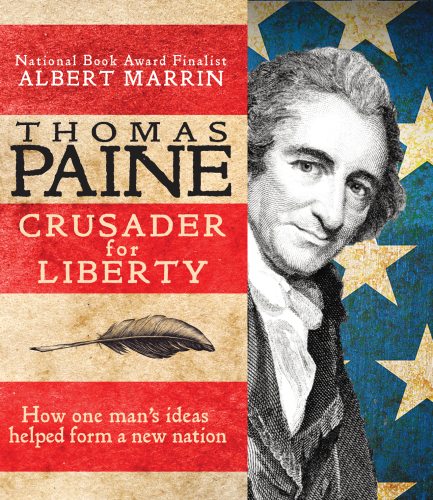
Thomas Paine
Crusader for Liberty: How One Man's Ideas Helped Form a New Nation
فرمت کتاب
ebook
تاریخ انتشار
2014
Lexile Score
1040
Reading Level
6-8
ATOS
7.7
Interest Level
4-8(MG)
نویسنده
Albert Marrinشابک
9780385386050
کتاب های مرتبط
- اطلاعات
- نقد و بررسی
- دیدگاه کاربران
نقد و بررسی

October 1, 2014
This exploration of Thomas Paine and his passionate writings in support of liberty provides insight into a turbulent period of change in the United States, England and France. Thomas Paine left 18th-century England with a letter of introduction from Benjamin Franklin and Philadelphia as his destination. Before long, Paine had a job as an editor of the Pennsylvania Magazine, and his life as a passionate writer of ideals was launched. Turning his initial focus from abolition to independence, Paine wrote Common Sense, the pamphlet that would make him a sensation and change the face of political writing. "He wrote for the common people, those like him. To influence them, he had to grab their attention by appealing to their intelligence and to their emotions." After supporting American independence, Paine turned his attention to the French Revolution, publishing The Rights of Man and landing himself in prison. Upon release, he began work on another controversial treatise, The Age of Reason, in which he criticized organized religion, especially Christianity. In a clear, straightforward narrative illustrated with archival images, Marrin provides the necessary context for readers to appreciate Paine's impact and the role he has played in the concept of "American exceptionalism." While it deliberately focuses on his ideas, there is still a clear picture of the man behind them.A valuable aid in understanding a historical period that continues to resonate. (notes, further reading, index) (Nonfiction. 10-16)
COPYRIGHT(2014) Kirkus Reviews, ALL RIGHTS RESERVED.

September 1, 2014
Gr 8 Up-Paine penned words more than 200 years ago that still resonate today, and acclaimed author Marrin documents this Founding Father's life and influence, using images, excerpts from primary source materials, and other resources. Within five hefty chapters, Marrin also introduces readers to class conflict, the Enlightenment, the American and French Revolutions, and slavery. Marrin's writing is uneven at times. He engages readers with the discussion of the Reign of Terror and what happened to Paine's body after his death. Elsewhere, the writing is textbooklike, and some statements, such as his comments about American exceptionalism and the Vietnam War, add little to his discussion of Paine. Each image is captioned and given a date, but at least one contains incorrect information. For instance, the caption for a poster that features a picture of Eugene Debs claims that it was used for Debs's campaign. The poster, which is partially cut off, was in fact created in the 1970s, decades after Debs's death in 1926. The author includes an extensive notes section, without image credits, and a suggested reading list of adult titles. Though Marrin is a well-regarded author and historian, this is not his best work.-Hilary Writt, Sullivan University, Lexington, KY
Copyright 2014 School Library Journal, LLC Used with permission.

September 1, 2014
Grades 5-8 Celebrated author Marrin elevates Thomas Paine from a one-sentence description in a history textbook into a fully realized person: son of a Quaker corset maker and possessor of a sharp memory, a charitable spirit, and an unflinching devotion to causes of liberty. Marrin opens with a brief description of the Enlightenment, followed by a look at Paine's youth and his immigration to America. The majority of the text, however, deals with his rubbing elbows with other founding fathers, reflecting on important events in the American colonies, and generating wildly popular propaganda for the cause of independence. Marrin also explains the far-reaching effects of Paine's writings, recounting how he was nearly beheaded during the Reign of Terror in revolutionary France and how his writings were publicly burned in England. Well illustrated, carefully researched, and drawn heavily from Paine's own works, this work is a straightforward biography of a figure rarely taught to kids, but it also celebrates the power of words and how ideas can change the world.(Reprinted with permission of Booklist, copyright 2014, American Library Association.)

























دیدگاه کاربران